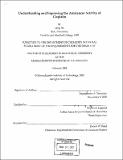Understanding and improving the anticancer activity of cisplatin
Author(s)
He, Qing, 1973-
DownloadFull printable version (23.07Mb)
Alternative title
Understanding and improving the anticancer activity of cis-diamminedichloroplatinum(II)
Other Contributors
Massachusetts Institute of Technology. Dept. of Chemistry.
Advisor
Stephen J. Lippard.
Terms of use
Metadata
Show full item recordAbstract
The purpose of this thesis is to further our understanding of the mechanism of action of cis-diamminedichloroplatinum(II) (cisplatin), one of the most effective anticancer drugs. Since its serendipitous discovery in 1970, cisplatin has served to help cure testicular cancer and treat a variety of human malignancies. It is widely accepted that DNA is the cellular target for cisplatin. Prior to this work, several structures of duplex DNA modified by cisplatin revealed the distinctive distortions caused by cisplatin-DNA adducts. High mobility group (HMG) domain proteins are DNA binding proteins that bind to cisplatin-modified DNA in vitro with high specificity and affinity. HMG-domain proteins block nucleotide excision repair of cisplatin-DNA adducts in vitro, suggesting that such proteins may mediate cisplatin cytotoxicity in cells. The structure of HMG1 domain A bound to site-specifically cisplatin modified DNA reveals an unprecedented protein-DNA binding mode and a key phenylalanine side-chain intercalation. Factors contributing to the affinity of HMG-domain proteins for cisplatin-modified DNA are not well understood. In Chapter 2 is described a biochemical approach to evaluate the contribution of intercalating residues to the affinity of HMG-domain proteins for platinated DNA. Site-directed mutagenesis, bandshifts and footprinting methods show that the position of the side-chain intercalator determines the protein binding mode. This study provides a new paradigm to understand why and how HMG domains interact with platinated DNA. In addition to understanding the molecular basis of protein platinated-DNA interaction, the role of HMG-domain proteins in the cisplatin mechanism was investigated on the cellular level. Overexpression of HMG1 had been predicted to enhance the sensitivity of mammalian cells to cisplatin. Previous attempts from our laboratory and others failed to overexpress HMG1 stably in cells. When it was reported that HMG1 mRNA is upregulated in mammalian breast cancer MCF-7 cells after estrogen treatment, the effects of steroid hormone treatment on HMG1 protein expression and cisplatin sensitivity in mammalian cell lines from breast and ovarian tumors were studied. The ability to modulate cisplatin sensitivity in cells has useful clinical implications such as enhancing the efficacy of cisplatin chemotherapy. The results of this study led to a phase I clinical trial to investigate the efficacy of hormonecarboplatin combination therapy for treatment of ovarian cancer patients. It can concluded from Chapters 2 and 3 respectively, that the affinity of HMG domains for cisplatin-modified DNA can be improved by protein modifications and that the cytotoxicity of cisplatin can be enhanced by HMG1 overexpression. Because cisplatin lesions are not natural targets for HMG domain proteins, the protein-DNA binding affinity may not be optimal. It is of interest to design novel proteins to be used in gene therapy for further improvement of the therapeutic effects of cisplatin in patients. In order to achieve this goal, the phage display method was employed to search for novel HMG domain proteins with higher affinity for cisplatin-modified DNA than those naturally occurring. It was successfully demonstrated that HMG-domains can be expressed on the phage surface, and protocols were established to enable selection for cisplatin-damaged DNA targets based on DNA structure rather than sequence. Chapter 4 sets the foundation for future phage display protocols to design proteins of high affinity for cisplatin-modified DNA.
Description
Thesis (Ph.D.)--Massachusetts Institute of Technology, Dept. of Chemistry, 2001. Vita. Includes bibliographical references.
Date issued
2001Department
Massachusetts Institute of Technology. Department of ChemistryPublisher
Massachusetts Institute of Technology
Keywords
Chemistry.